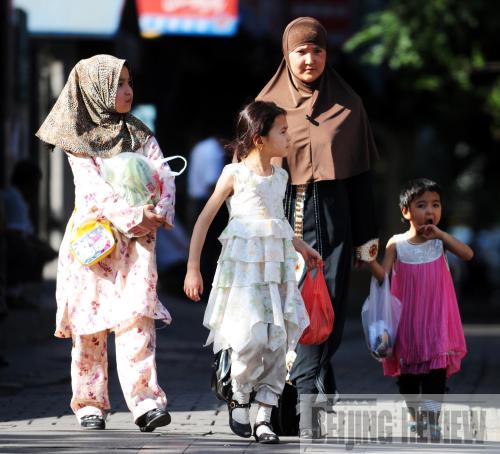|
 |
|
CLOSER TO FINE: A Uygur woman takes her three daughters on a shopping trip in downtown Urumqi on July 12 (SHA DATI) |
The capital of Xinjiang Uygur Autonomous Region, Urumqi, is getting back to normal a week after July 5's fatal riot, despite sporadic tension.
Xinhua News Agency reported that traffic jams reappeared on the city's major streets on July 13, a rare scene since the unrest.
The news agency also quoted railway authorities as saying that the situation at Urumqi's train terminal was normal. Officials on July 11 said 21,000 people used the station that day, down by 4,000 from the previous day's total.
"There are neither so-called 'waves of refugees' nor ticket scalpers in the train terminal as reported by some foreign journalists," Chen Kai, vice chief of the South Train Station of Urumqi, told Xinhua.
On July 15, the regional government said the riot's death toll had risen to 192 and hospitals had treated 1,721 injured people, 881 of whom were still hospitalized and 66 of whom were listed in critical condition.
The government will pay all medical bills for civilians injured during the riot and also grant them living subsidies during their hospitalization, said Nur Bekri, Chairman of the regional government, during a July 12 televised speech.
The government has also said that victims' families are to receive 210,000 yuan ($30,900) in compensation for each person. The compensation includes a one-time disbursement of 200,000 yuan ($29,400) and a funeral allowance of 10,000 yuan ($1,500). The government now estimates that compensation for people injured or killed during the incident would add up to more than 100 million yuan ($15 million). As of July 12, the government had already granted 4.2 million yuan ($617,000) to the families of 21 victims.
According to Xinhua, the Urumqi's Public Security Bureau on July 11 said in a notice that the situation had been put back under control, though there still had been sporadic illegal assemblies and demonstrations in some places.
Police will disperse such illegal assemblies according to the law and are entitled to take necessary measures if the crowd refuses to disperse, it said. Police will remove those who resist police orders, or will detain such people at the scene.
On July 14, the London-based risk analysis firm Stirling Assynt issued a report that stated an Al-Qaeda affiliate had vowed to avenge the deaths of Uygurs in Urumqi by targeting Chinese workers in North Africa. According to China Daily, Al-Qaeda's Algerian-based offshoot, Al-Qaeda in the Islamic Maghreb, called for reprisals by targeting the 50,000 Chinese workers in Algeria as well as Chinese projects and workers across northwest Africa.
On the same day, China's embassy in Algeria called on its citizens to be wary. "Considering the situation since the outbreak of riots in Urumqi on July 5, the embassy is calling on Chinese-funded organizations and personnel to raise their security awareness and strengthen security measures," said a statement on the embassy website.
Devastated tourism
The downtown Urumqi International Bazaar, a popular tourism spot filled with souvenir shops, restaurants and venues for traditional ethnic singing and dancing has been hit hardest as a result of the riot. On July 5, mobs destroyed many stores and more than 10 tourism group buses in the area. Xinhua reported that many of the bazaar shops had reopened for business by July 13, and traffic controls had also been lifted.
Despite the return to normalcy, the wounds to local tourism could take time to heal. Inam Nasirdin, Director of the Xinjiang Tourism Administration, said at a July 11 press conference that 1,450 tour groups, accounting for up to 85,000 tourists, had cancelled their plans because of the unrest. Tourism in other popular Xinjiang spots also plummeted following the riot.
The local official also said the region must promote its tourism at international trade fairs and forums to reduce the impact caused by the riot. The tourism administration will also try lobbying the Central Government to hold more international activities in Xinjiang. Tourism committees, agencies and hotels in the region are being asked to take measures to ensure the safety of visitors.
Xinjiang's tourism has seen strong growth over the last five years. More than 22.3 million tourists flocked to the area in 2008. Inam Nasirdin told Beijing Review in May that his administration was striving to attract tourists from other parts of China in efforts to offset the impact of the global financial slowdown.
| 